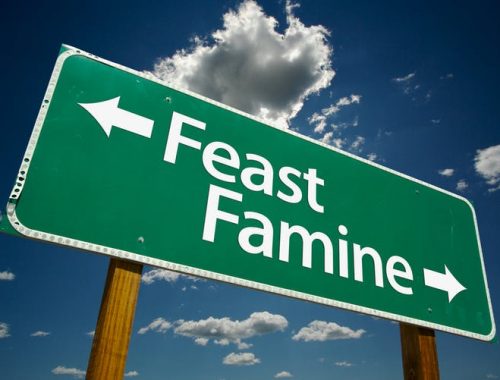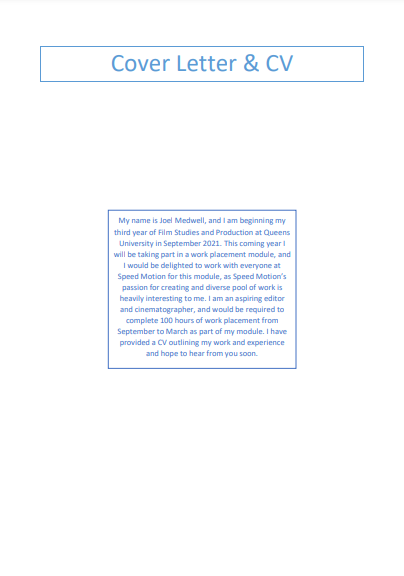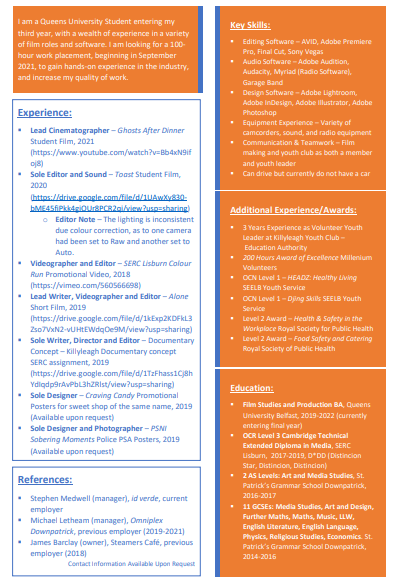Summer Stressin’, Havin’ a Blast
Summer, a time to relax and gather your thoughts in order to prepare yourself for the upcoming academic year. Or in my case, a chance to overload your schedule and make finding a placement much harder than it need be. In this blog I will be recounting my application process using Gibb’s reflective model, highlighting my success and failure, to better prepare myself for the future.

Cover Letter & CV Drafting – The beginning
With placement applications in sight, our module coordinator Lucy Baxter provided us with example CVs used by past pupils outlining that film industry CVs take a slightly different form than that of a traditional CV. Using an example as my framework I redesigned my CV to fit with this structure, part of which was adding previous film and film adjacent projects as experience, providing links and Google Drive access to studios.
In doing so I had hoped to present myself as more professional and appealing to studios and I feel that I had done this to the best of my ability.
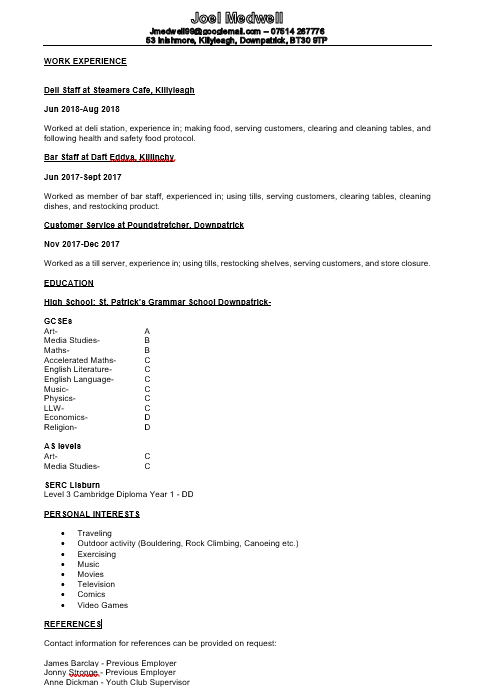
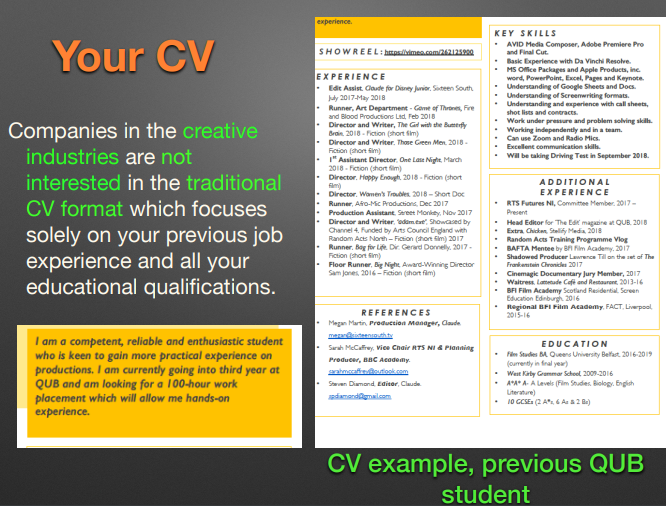
Cover Letter & CV Drafting – What I learned
Creating this new CV led to a better understanding of film industry standards and practices however I also became aware of my lack of experience and credits within the industry itself, as the majority of my work until now has been amateur, school graded, projects.
“A winning CV must make the recruiter’s job as easy as possible. During Application those finally selected for interview will be those who have given clear, concise information, and evidence, to convince the reader that they are worth seeing. Evidence can cover a number of areas such as skills, experience, qualifications and achievements. If insufficient evidence is presented, recruiters will be unable to justify to themselves, or to their superiors, the arrangement of an interview.”
Jones, Alan. How to Write a Winning CV: A Simple Step-by-Step Guide to Creating the Perfect CV. 1996 p2-3
Cover Letter & CV Drafting – Moving forward
In light of this, a focus of mine going forward is to seek out and partake in any and all projects that are available to me in order to broaden my experience and gain additional, non-academic credits.
Cover Letter & CV Drafting – Final thoughts
To conclude there is not much more I could have done during the CV process which would have furthered my chances, however, there is much I could have done in preparation for industry employment in general, and so this experience taught me to constantly plan for future work and projects and make searching for opportunities to develop skills and practices part of my day-to-day routine.
The Application Process – Background
Following the completion of my first CV draft, I emailed it to a relative who works in journalism to allow a fresh pair of eyes to look over my wording and structure. And then I began to work my way through the work placement options that had been provided by Queen’s University. I created a word document listing the options for film and gave a brief summary of their website and/or social page(s), previous projects that I liked, and my general opinion of them, highlighting those I viewed as most promising in bold.
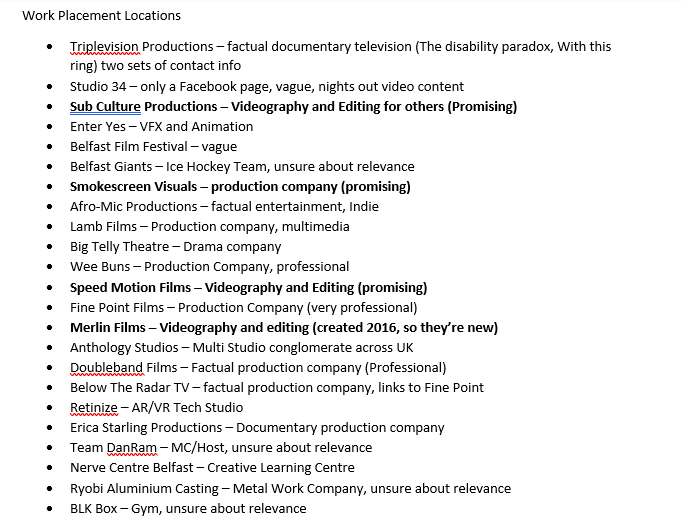
After familiarising myself with my options and researching them more thoroughly I received feedback on my CV, I was made aware that it lacked a personal feel and direct acknowledgement of the potential employer and so I retooled my CV into a template leaving gaps for information on the given studio in order to personalise it for each of them.
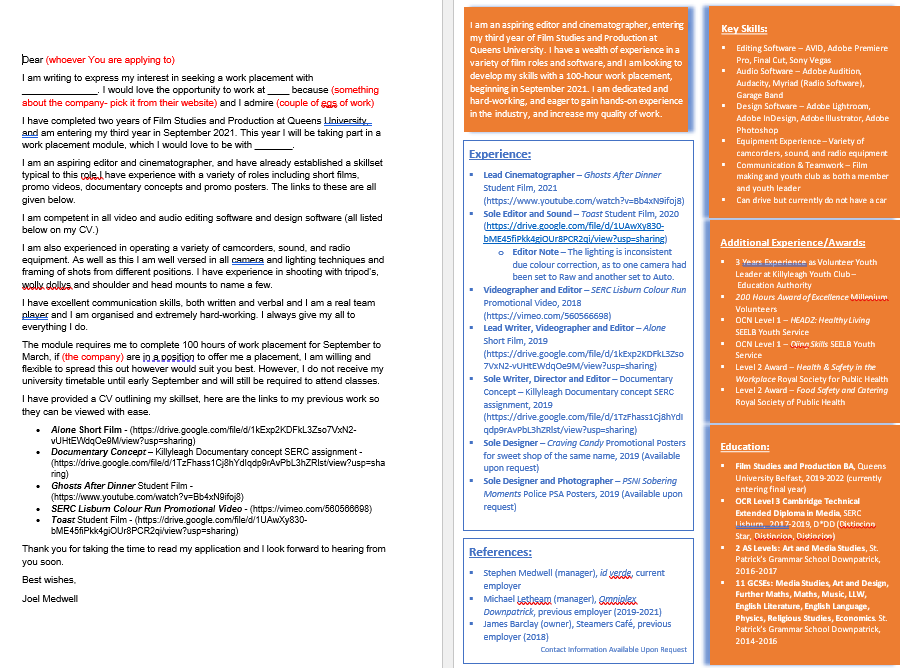
I then selected a couple of studios to email my cover letter and CV to, as I had been advised by my course coordinator not to cast my net too wide and to show interest by contacting the same studio a number of times. Additionally, if no response was given I was to contact them via phone number in order to receive a definitive answer before moving on, however, due to my work hours over the summer being 7am to 5pm and the film studios either not having a phone line or having one that was only open 9am to 5pm, it became impossible for me to contact them this way.
And so, I emailed each company twice leaving a few days between each and if I received no response after two emails I moved on to the next on my list. A number of studios responded informing me that they did not take student work placements, or that they were unable to do so during the academic year, as time went on some studios responded stating that their placement slots had already been filled up, causing me to lose hope, but I remained persistent. During this time my course coordinator Lucy had referred me to another member of university staff Aileen Carson who was assisting me by researching potential new placement options which I could send my CVs through her as a contact. Towards the end of August, I received an email from my course co-ordinator about a new work placement opportunity with a company named Profile Tree, and I constructed a CV for their video editor position and emailed them immediately, however, I heard no word back, and upon seeing a fellow student email Lucy back stating his confirmed place on the placement I had assumed the spot was taken and continued working with Aileen to find something else. After two weeks of continued emailing, Aileen suggested requesting CV feedback from the companies I had already emailed to see if they had any feedback which I could use to improve my chances, and so I emailed the most recent two again (Profile Tree and Wolfhound Media), and Profile Tree responded apologising as they thought they had already emailed me back and offered me a placement.
The Application Process – Thought and Feelings
Throughout the application process, I felt a near-constant sense of worry due to late or lack of response from companies, which grew worse as the deadline for work placement neared, and frustration as I was unable to contact the companies directly, compounded by the fact that I had been the one to put myself in this position. And finally, relief and gratitude when my persistence paid off after a small push from Aileen.
The Application Process – Pros and Cons
Although these feelings generally created a negative experience, it was good in the sense that it was a necessary teaching moment outlining the difficulties in finding work in the film industry and the need for persistence and availability in a competitive industry. Had I been more aggressive in my approach, to begin with, I may have saved myself a great deal of anxiety and stress.
The Application – Future Plans
Going forward, should I ever be in a similar circumstance, more detailed planning ahead of time which takes into consideration the entire process, rather than the end goal, and considering all the ramifications of my actions, however well-intentioned, are my top priority. Alongside aiming to maximise my availability across the board, rather than counting my chickens before they hatch. This process of preparation and multitasking is a vital part of the creative industry as McRobbie explains.
“Those working in the creative sector cannot simply rely on old working patterns associated with the art worlds, they have to find new ways of ‘working’ the new cultural economy, which increasingly means holding down three or four ‘projects’ at once. This becomes a necessity as, in a crowded and competitive field, charges to the client fall (to pick up the business), and consequently to make ends meet the ‘cultural entrepreneur’ must be running several jobs at once.”
McRobbie, Angela. Be Creative: Making a Living in the New Culture Industries. 2016 p19-20
You May Also Like

Facing Avoidance
26 November 2021
Assumption – the Parent of Confusion
24 November 2021